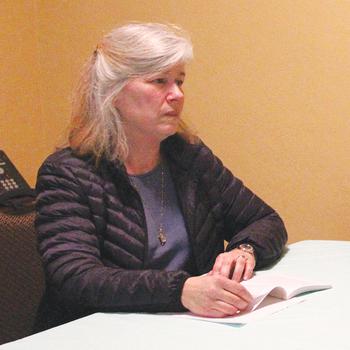|
Clergy abuse crisis gets a fresh reading in parish study group
By Nicholas Wolfram Smith
Catholic San Francisco - Archdiocese of San Francisco
February 10, 2020
https://catholic-sf.org/news/clergy-abuse-crisis-gets-a-fresh-reading-in-parish-study-group
 |
A year-and-a-half after the Catholic Church in the U.S. suffered devastating and disheartening revelations of systematic abuse, have Catholics moved on?
Months after the coverage of sexual abuse has died down, a group of parishioners convened at St. Gregory Parish in San Mateo to discuss it again and how Catholics should respond.
Cindy Gherini, a parishioner at St. Gregory, said after now-laicized Cardinal Theodore McCarrick was accused of sexual abuse and a grand jury in Pennsylvania published a report on how state dioceses handled clergy abuse, her parish held a community discussion about what was going on. During that meeting, Gherini said, there was an outpouring of grief and anger.
“And then it died after that, so to speak. Nobody led us forward,” she said. “How much longer can we stay in those emotions and not move forward?”
What gave her direction was a short pamphlet written by Los Angeles Auxiliary Bishop Robert Barron and published by Word on Fire Catholic Ministries, “Letter to a Suffering Church: A Bishop Speaks on the Sexual Abuse Crisis.”
According to its preface, Bishop Barron wrote the booklet to support Catholics who are “demoralized, scandalized, angry beyond words and ready to quit.” He gives a spiritual and historical overview of the abuse crisis and urges people to stay and work for a holier church.
Gherini said after reading it she decided to form a study group around it at St. Gregory.
“I was really amazed how it was written, that it would take us step by step through thoughts and feelings and emotions and lead us in a direction,” she said.
The parish handed out free copies of the book to parishioners and a group met for three weeks, during which the half-dozen attendees discussed the text and what they thought about it. St. Gregory associate pastor Father Oliver Ortese attended some of the meetings to offer his perspective as a Nigerian priest.
Larry Garvey, one of the meeting participants, said reading Bishop Barron’s pamphlet helped address some of the anger he still felt over clergy abuse. He appreciated the way the pamphlet placed the church’s failures in a historical context, showing that after great periods of sin came great reformers.
“For Barron, this is a reform moment and we as laity have work ahead of us,” he said.
He added that Bishop Barron also helped him clear up his misconceptions about the church’s response.
“Without a book like this, it’s easy to make assumptions – the book adds real enlightenment about what happened and what might have allowed it to persist,” he said.
Bishop Barron in his book lays out the direction the church has been heading in on clergy abuse. Procedurally, the Charter for the Protection of Children and Young People, established by the U.S. bishops in 2002, has helped decrease the number of cases of recently committed abuse. Pope Francis’ document “Vos estis lux mundi” (“You are the light of the world,”) published shortly after the book came out, lays out additional canonical penalties for abuse of a minor and for covering up such crimes.
More than processes, though, Bishop Barron called for a “deep and abiding spiritual reform.” Criticizing a culture in which numerous priests lacked any sexual restraint and bishops felt free to shuffle criminal offenders between parishes, Bishop Barron called for a renewal of the priesthood. Because abusive priests grew up in Catholic homes and within a Catholic culture, Bishop Barron encouraged a lay renewal as well.
“We are the culture and some of this is our responsibility, so we need to clean our own house,” Garvey said. “If we want better priests we need better laity.”
Evangelizing, doing corporal and spiritual works of mercy, and helping to promote catechesis were some of the solutions that appealed to the group, although they felt evangelization was a particular challenge.
Gherini endorsed adult faith formation classes, like RCIA, for Catholics to learn more about what the church teaches. “How do you inspire more people to come and learn instead of checking in and checking out,” she said. She added that Bishop Barron’s emphasis on empowering the laity “really stood out to me” and was “healing” to read.
Parishioner Susan Arms said she took away from it a greater desire to affirm priests in their vocation. “What I want to do is support our priests and say you’re doing a great job, you gave a great homily. They have a difficult life, so what can I do to support our priests and encourage them,” she said.
For all the good that came out of the study group, Garvey said he found the “depressingly low number” of people interested in meeting to discuss it disheartening. “I don’t know if people just don’t care or don’t want to figure it out,” he said.
Arms suggested that many of those deeply disturbed by the abuse may have left, while the ones who stayed may “be ready to just move on.”
Those who left the church over abuse are another important group Catholics need to pay attention to, Garvey said.
“I think part of what we need to do is convince people who have left that it’s not the same. We’ll never be perfect, but this won’t be what it was,” he said, adding that reading the book had given him more confidence in the church’s response to the abuse crisis than he held at the beginning of the study group.
Arms said reading the book “gives us hope the church is going to prevail. He really calls those who read it to take action, do something and be part of the solution. We need to be responsible, too.”
|
